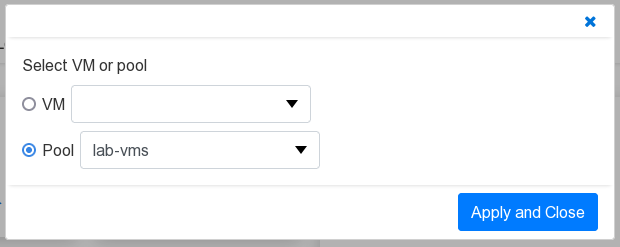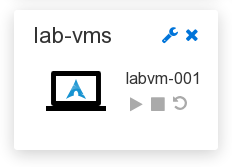Advanced
VM Pools
Since 4.0.0
Not all VMs are defined as replacements for carefully maintained individual PCs. In many workplaces, a standardardized VM configuration can be used where all user-specific data is stored in each user’s home directory. By using a shared file system for home directories, users can login on any VM and find themselves in their personal environment.
If only a subset of users require access simultaneously, this makes it possible to define a pool of standardardized VMs and dynamically assign them to users as needed, eliminating the need to define a dedicated VM for each user.
Pool definitions
The VM-operator supports this use case with a CRD for pools.
apiVersion: "vmoperator.jdrupes.org/v1"
kind: VmPool
metadata:
namespace: vmop-dev
name: test-vms
spec:
retention: "PT4h"
loginOnAssignment: true
permissions:
- user: admin
may:
- accessConsole
- start
- role: user
may:
- accessConsole
- start
The retention specifies how long the assignment of a VM from the pool to
a user remains valid after the user closes the console. This ensures that
a user can resume work within this timeframe without the risk of another
user taking over the VM. The time is specified as an
ISO 8601 duration.
Specifying an ISO 8601 time is also supported, but if you consider
using an absolute time, check again whether a dedicated VM for the user
isn’t the more appropriate choice.
Setting loginOnAssignment to true (defaults to false) triggers automatic
login of the user (as described in section auto login)
when the VM is assigned. The permissions property specifies the actions
that users or roles can perform on assigned VMs. The may property defaults
to [accessConsole] if not specified.
VMs become members of one (or more) pools by adding the pool name to
the spec.pools array in the VM definition, as shown below:
apiVersion: "vmoperator.jdrupes.org/v1"
kind: VirtualMachine
spec:
pools:
- test-vms
Accessing a VM from the pool
Users can access a VM from a pool using the widget described in user view. The widget must be configured to provide access to a pool instead of to a specific VM.

Assignment happens when the “Start” icon is clicked. If the assigned VM is not already running, it will be started automatically. The assigned VM’s name apears in the widget above the action icons.

Apart from showing the assigned VM, the widget behaves in the same way as when configured for accessing a specific VM.
Guest OS Requirements
To ensure proper functionality when using VM pools, certain requirements must be met on the guest OS.
Shared file system
All VMs in the pool must mount a shared file system as the home directory. When using the sample agent, the file system must support POSIX file access control lists (ACLs).
User management
All VMs in the pool must map a given user name to the same user id. This is typically accomplished by using a central user management, such as LDAP. The drawback of such a solution is that it is rather complicated to configure.
As an alternative, the sample auto login agent provides a very simple approach that uses the shared home directory for managing the user ids. Simplified, the script searches for a home directory with the given user name and derives the user id from it. It then checks if the user id is known by the guest operating system. If not, the user is added.
Details can be found in the comments of the sample script.
